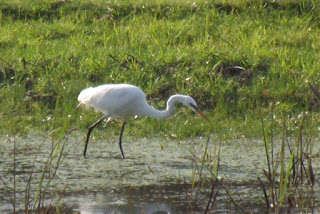Spending time in nature provides many benefits—not only physical ones, but intellectual and emotional ones, as well. Let's take a look at one of my favorite natural places to visit: Sam D. Hamilton Noxubee National Wildlife Refuge.
It’s a warm, sunny day in late March. Looking down from Goose Overlook, I marvel at
how the surface of Bluff Lake reflects the blue skies and cottony white cumulus
clouds like a mirror.
A Northern Cardinal chirps out his song from the spiky
branches of a fallen cypress tree.
Breeding season is in full swing, at least for some species.
A Great Egret hunts patiently in the shallows. Its black legs and toes are long and spindly,
facilitating wading.
Splash! Lightning-quick
reflexes are a must.
On the prowl…
“What’re you lookin’ at?”
The main food source here seems to be minnows. This egret probably had a lot of success today.
A crossvine (Bignonia
capreolata) trails up the trunk of a tree near the
boardwalk. Note the red-and-yellow
trumpet-shaped flowers and the long, unlobed leaves.
On Woodpecker Trail, which loops through a section of pine woods,
a few common blue violets (Viola sororia)
can be seen near the path.
Woodpecker trail is also a good place to observe endangered Red-cockaded
Woodpeckers, but I don’t hear or see any today.
Pileated, Red-bellied, and Downy Woodpeckers make themselves noticed,
though. Songbirds, including Blue-gray
Gnatcatchers, Carolina Chickadees, and Yellow-throated, Yellow-rumped, and Pine
Warblers, sing and flit around in the lower forest canopy.
The delicate white blossoms of a flowering dogwood (Cornus florida) stand out against the
subdued grays and greens of the forest behind them.
I go back to Bluff Lake, this time to the Cypress Cove
Boardwalk, and observe a large American alligator basking in the
sun. Yellow-throated and Yellow-rumped
Warblers are vocal here, just as they were on Woodpecker Trail. Red-winged Blackbirds add their bugling to the
mix.
The Yellow-throated Warblers may be vocal, but they’re not
necessarily easy to photograph. One
moves down to the lower branches of a cypress, but is backlit at first.
I try photographing it from another angle. Yellow-throated Warblers are actually fairly
subdued in plumage—the sunny yellow of the throat is offset by the subtle
slate-gray back, white wing bars, black mask, and black streaks against white
flanks.
As the sun drops lower in the sky, I take a look at a large
cottonmouth sunning itself on a log at the edge of Bluff Lake. Although I’m glad to be a safe distance from
this very venomous snake, I do not begrudge it the space it inhabits here at
Noxubee. It fills a niche in the
ecosystem that is no less significant than those of the more easily-appreciated things in nature—e.g., birds, flowers, and trees.
It’s getting late. Bird-voiced
treefrogs begin calling from the cypress swamp, their whistling songs mingling with
the piping ones of spring peepers. I
know that, later in the season, the spring peepers will be silent, but green
treefrogs, gray treefrogs, cricket frogs, and others will fill in the
chorus. I will return soon.















No comments:
Post a Comment